You are here
Overview | San Juan Islands National Monument, National Wildlife Refuge, and National Historical Park | North Islands | Orcas Island and Around | San Juan Island and Around | Lopez Island and Around | Camping + Lodging | Ferries | Weather + Water Hazards
San Juan Islands overview
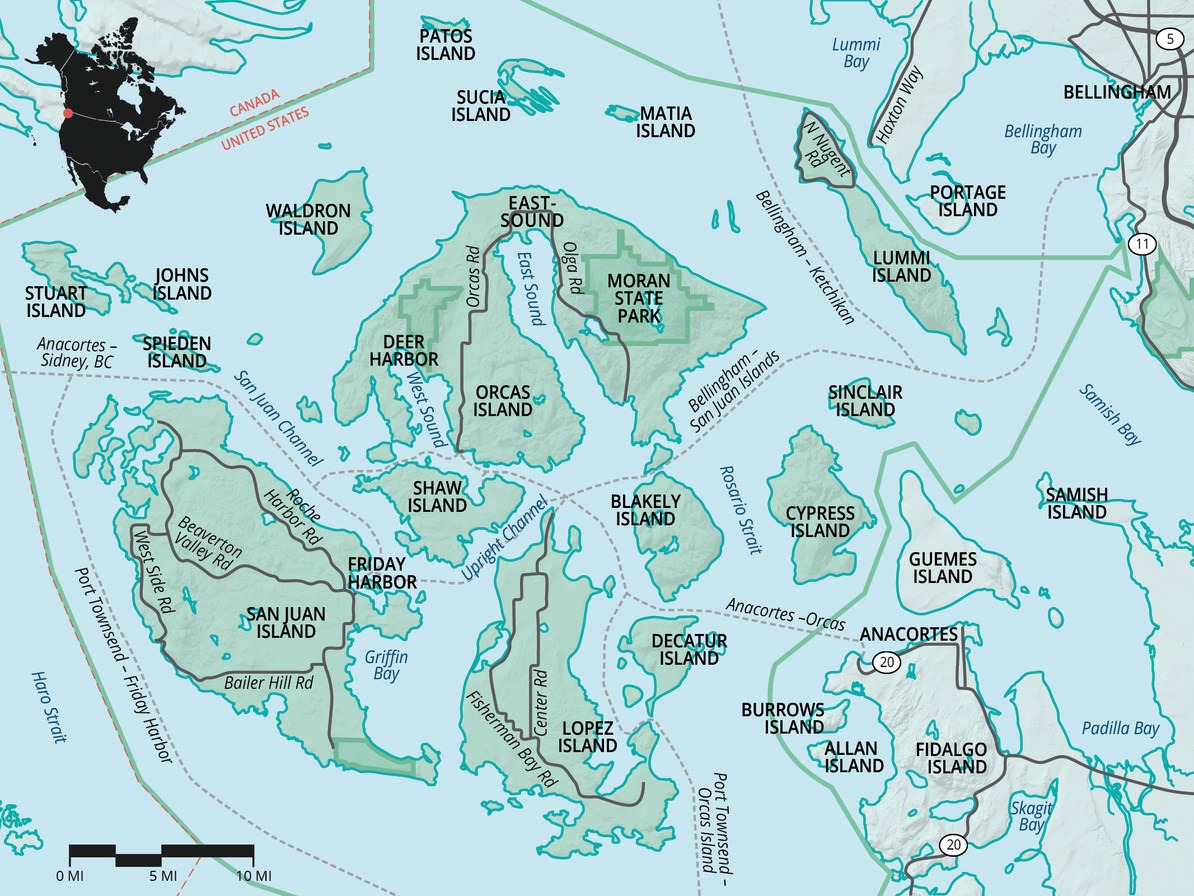
Graceful, wild, and incredibly picturesque, the San Juan Islands consist of more than 124 named islands and hundreds more unnamed formations that are clustered together at the intersection of the Strait of Georgia and the Strait of Juan de Fuca in the Salish Sea. These islands sit at the northwestern corner of the U.S. as an enticing maze, with each destination just a short sail, paddle, or ferry ride away from the last. Come here prepared to lose yourself in the intricacies of scenes that seem impossibly balanced and poised: a wind-sculpted pine populates a lonely island, an orca's dorsal fin plies the placid sound, a snow-capped peak looms in the distance, and the whole scene blushes as the sun sets.
Each year more than a million visitors make their way north by car and by boat to experience a portion of this harmony, and yet the distribution of the islands and the traffic patterns of the visitors mean that a world of solitude and escape is easy to find if you are willing to stray just a little from the established traveling routes. The incredible network of marine parks managed by Washington State ensures that camping opportunities are widely available throughout the islands, and the short distances between them are very doable for paddlers who are trained on the basics of navigation, weather, and sea kayaking safety. If sailing is your preference, the assortment of bays and moorages will keep you wandering for weeks. Alternately you can choose a more terrestrial mode: ride a bike onto the ferry in Anacortes, disembark on Orcas, and spend a week touring the island from one shore to the next, or pack a backpack and hit any number of the island trails.
In addition to the unique landscape and touring opportunities, the San Juan Islands are perhaps best known for the astounding variety of wildlife that resides in or migrates through the area annually. Ubiquitous harbor seals haul out on the rocks along with Stellar sea lions, and supine sea otters use stones to grind away at mussel shells. Beneath the surface, minke whales, Dall's porpoises, and pods of orcas circulate around the islands. The orca pods attract the always popular boat tours. In the San Juans the bird life is equally rich; there are more bald eagles here than anywhere else in the country, and visitors can also expect to see herons, swans, and peregrine falcons in addition to cormorants, rhinoceros auklets, pigeon guillemots, and marbled murrelets. While getting to the San Juans may take some planning and commitment, it is this very remoteness that has helped preserve a quality of wildlife habitat that is unique along the West Coast. Indeed, frigid waters notwithstanding, even the scuba diving is legendary.
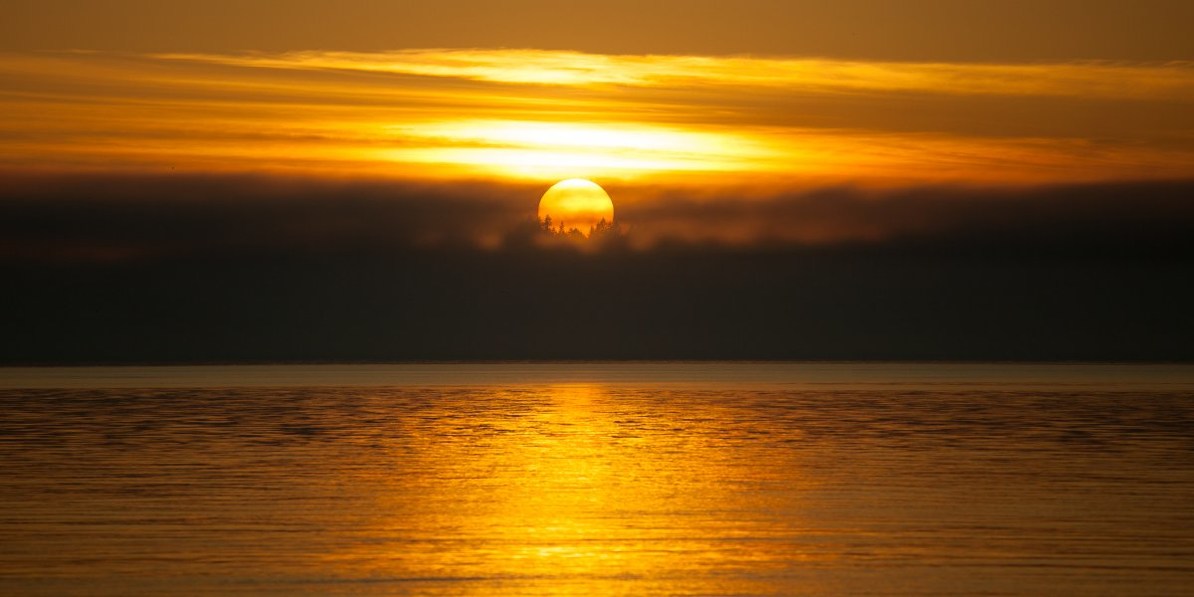
Sunset over the Salish Sea. Photo by Matthew Williams.
As you explore, please remember that some of the most attractive attributes of these islands are also some of the most fragile. Unprotected islands without infrastructure are especially vulnerable to the impacts of regular traffic in the form of boat landings, hiking, and camping. Consider appreciating these islands from the water to ensure their long-term health, and always observe Leave No Trace principles as you travel through the San Juans. While San Juan County has taken the extraordinary step of adopting a Leave No Trace ethic (the first U.S. county to ever do so), it is up to each visitor to respect the land and the culture, plants, and animals that live in this delicate place.
Whether you are hiking, biking, sailing, paddling, or simply ferrying through, these islands will leave an indelible mark in your memory. Below you'll find links to adventures and lodgings to help get you started, and this is just the beginning. The San Juan Islands are a destination you'll want to return to again and again, so book your ferry ticket, reserve your campsites if you can, and prepare to start your relationship with this remarkable place.
San Juan Islands National Monument, National Wildlife Refuge, and National Historical Park
A plethora of parks, preserves, and refuges exist throughout the San Juan Islands in an effort to balance recreational access and enjoyment with the protection and preservation of natural resources, and an assortment of government agencies oversee their administration.
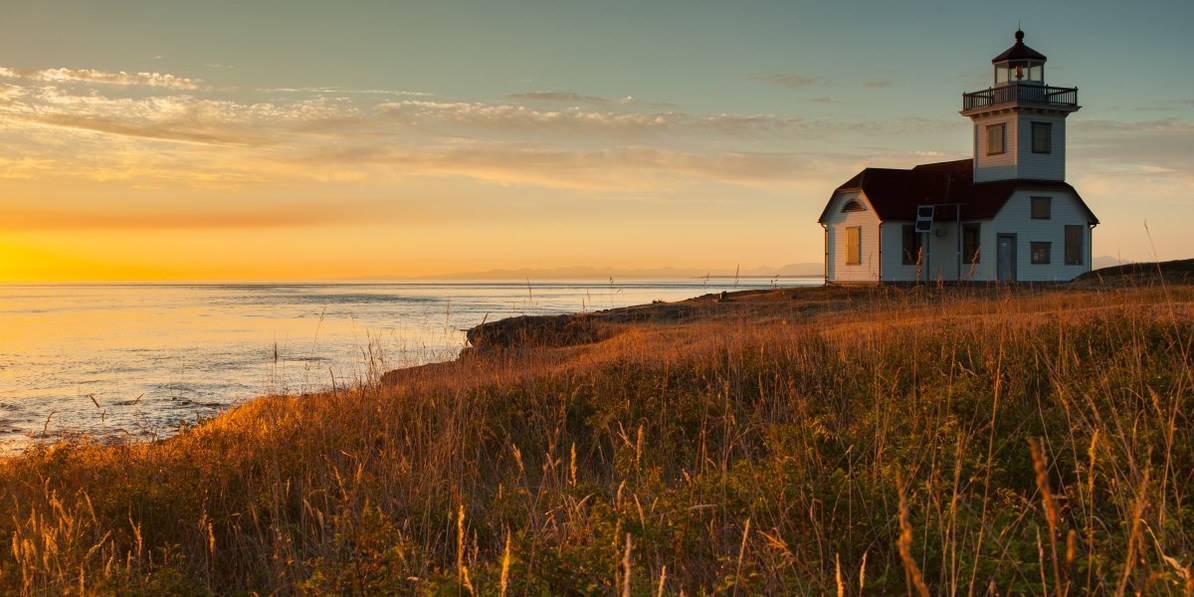
The sun sets over the Patos Island Lighthouse. Photo by Matthew Williams.
- The San Juan Islands National Monument consists of 77 separate sites distributed throughout the archipelago that total approximately 1,000 acres. Established on March 25, 2013, and administered by the Bureau of Land Management, the monument includes several small and unnamed rocks in addition to some larger tracts and, in some cases, as with Patos Island, entire islands.
- The U.S. Fish and Wildlife Service protects 84 locations throughout the San Juan Islands National Wildlife Refuge, which was established in 1976 and totals approximately 450 acres. The majority of these locations are wilderness areas and are off-limits. Visitors cannot come closer than 200 yards to these protected rocks and islands, but there are excellent wildlife observation opportunities offshore. The exceptions are Turn Island and Matia Island, both of which are part of the refuge and have campgrounds and trail systems that are managed by Washington State Parks.
- San Juan Islands National Historical Park on San Juan Island is administered by the National Parks Service and includes two sites that total approximately 2,000 acres. The two sites mark the English and American camps that were established on the island in 1859 as tensions over border disputes escalated. Wartime preparations were afoot on both sides, triggered by, of all things, the killing of a British pig that trespassed onto an American farm and was shot by the irate landowner. The park delves into a fascinating chapter in the history of these islands, and it is well worth a stop.
North Islands
The trio of Patos, Sucia, and Matia islands offer some of the best perspectives into protected lands in the San Juans. Matia Island is part of the San Juan Islands National Wildlife Refuge, Patos Island is part of the San Juan Islands National Monument, and Sucia Island is a state park. You can stay on Sucia Island and enjoy the amazing sunsets from the coves and bays, or you can easily paddle over from Orcas Island.
- Sucia Island: Fox Point Sea Kayaking
- Sucia Island Hiking Trail System
- Sucia Island to Matia Island Sea Kayaking
- Matia Island State Park
- Patos Island
Orcas Island and around
Orcas Island is the largest in the archipelago, and Eastsound is the second largest town in the islands. The East Sound runs deep into the middle of the island and creates eastern and western lobes. To the east visitors will find Moran State Park (home to Mount Constitution, the tallest point in the islands), Olga, and Obstruction Pass State Park; to the west visitors will find the West Sound, Turtle Island Preserve, and close access to Shaw Island.
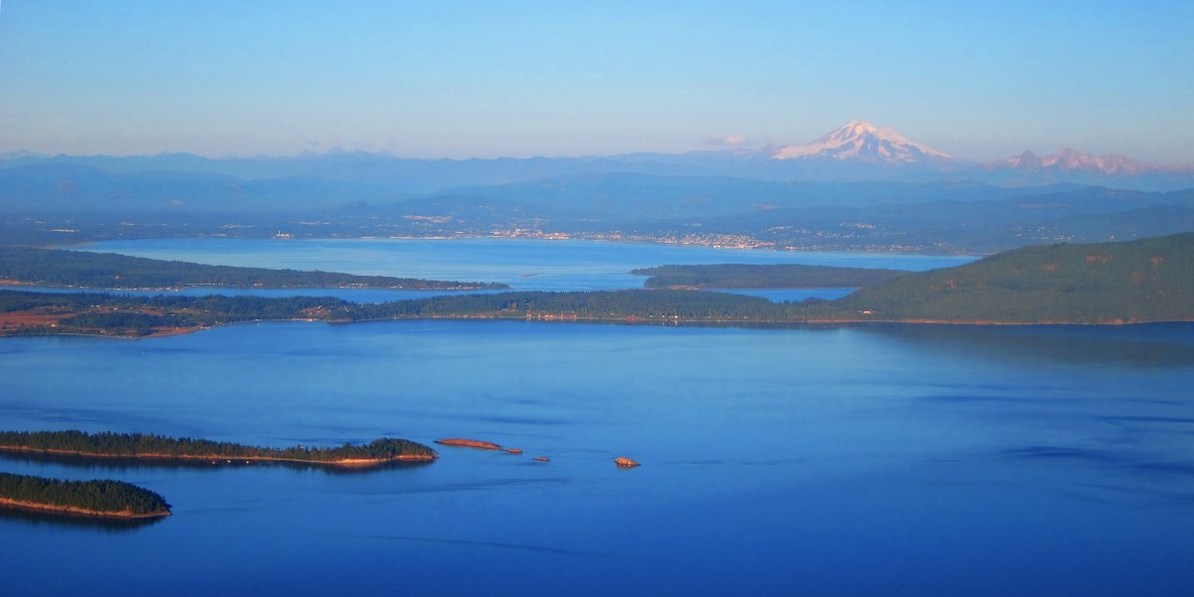
The view from the summit of Mount Constitution. Photo by Shane Kucera.
- Orcas Island to Sucia Island Sea Kayaking
- Orcas Island: North Beach
- Orcas Island: Crescent Beach at Ship Bay
- Orcas Island: Fishing Bay Paddle
- Orcas Island: Turtleback Mountain Preserve
- Orcas Island: Mount Constitution Hike
- Orcas Island: Cold Springs Trail to Mount Constitution Summit
- Orcas Island: Cascade Lake
- Orcas Island: Spring Bay
- Orcas Island: Olga Beach + Pier
- Orcas Island: Sea Kayaking Obstruction Pass Beach to Cascade Bay
- Orcas Island: Obstruction Pass Beach
- Obstruction Island Sea Kayaking
- Elwha Beach + Pier
- Massacre Bay + Skull Rock Sea Kayaking via West Sound
- Blind Island Sea Kayaking via Elwah Bay
- West Sound: White Beach Bay Sea Kayaking
- Deer Harbor Sea Kayaking via Cayou Quay Marina
- Pointe Kimple + Freeman Island Sea Kayaking via West Beach
- Point Doughty State Park
San Juan Island and around
With Friday Harbor on the east side and Roche Harbor on the west, San Juan Island is home to the largest number of year-round residents. Friday Harbor receives the brunt of tourist ferry traffic throughout the year, yet it remains a charming and appealing place to stay and explore. Shaw Island, among several others, is easily accessible from Friday Harbor. If your desire is to explore inland, the San Juan Island National Historical Park provides a fascinating look into some of the political conflicts and brinksmanship that circulated around these disputed waters.
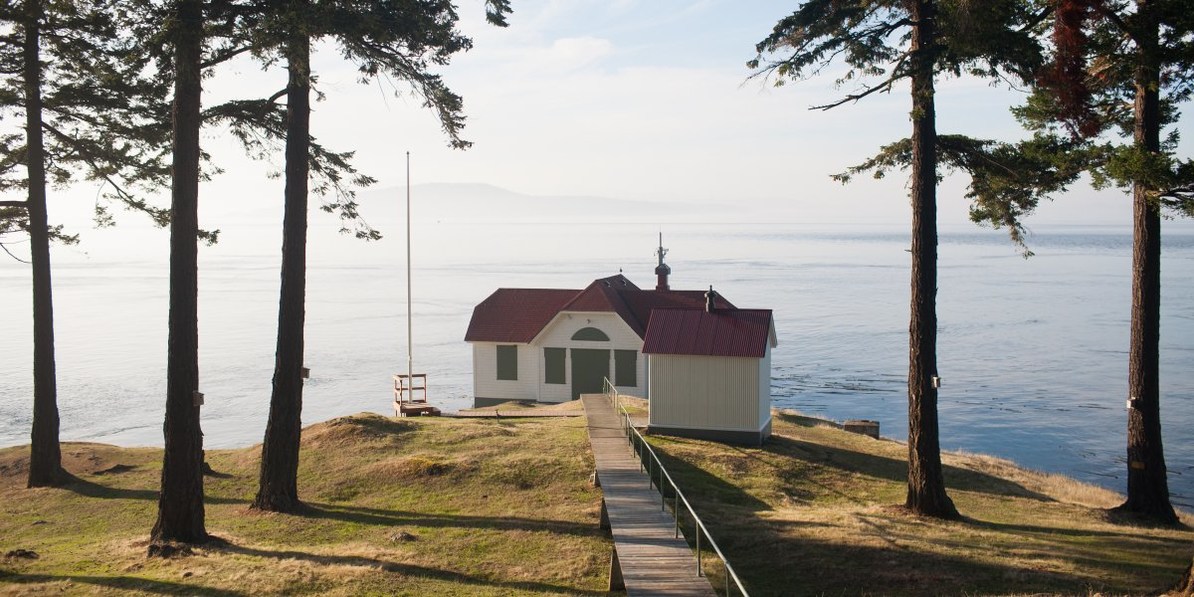
Turn Point Lighthouse. Photo by Matthew Williams.
- Posey Island Sea Kayaking
- San Juan Island: Sea Kayaking Smallpox Bay to Deadman Bay
- San Juan Island: Lime Kiln Point State Park
- San Juan Island: Friday Harbor Sea Kayaking
- San Juan Island National Historical Park
- Johns Island Sea Kayaking
- Jones Island Sea Kayaking
- Turn Island State Park Sea Kayaking
- Shaw Island Circumnavigation
- Stuart Island Sea Kayaking
- Stuart Island State Park
- San Juan Island: Cattle Point Natural Resources Conservation Area
- San Juan Island: Cattle Point Sea Kayaking
- Anacortes to Friday Harbor Sea Kayaking
- Mount Young + Bell Point
- San Juan Island: San Juan County Day Park
- San Juan Island: Jakle's Lagoon
Lopez Island and around
Lopez is the third largest island, and its year-round population is close to that of the town of Friday Harbor. This means that, of the major islands, Lopez is a beautiful spot to visit and a nice option if you are looking for smaller crowds. For this reason, Lopez is a popular with cyclists who can ride in relatively light traffic patterns on good roads throughout the island while still enjoying convenient lodging, dining, and tourist amenities.
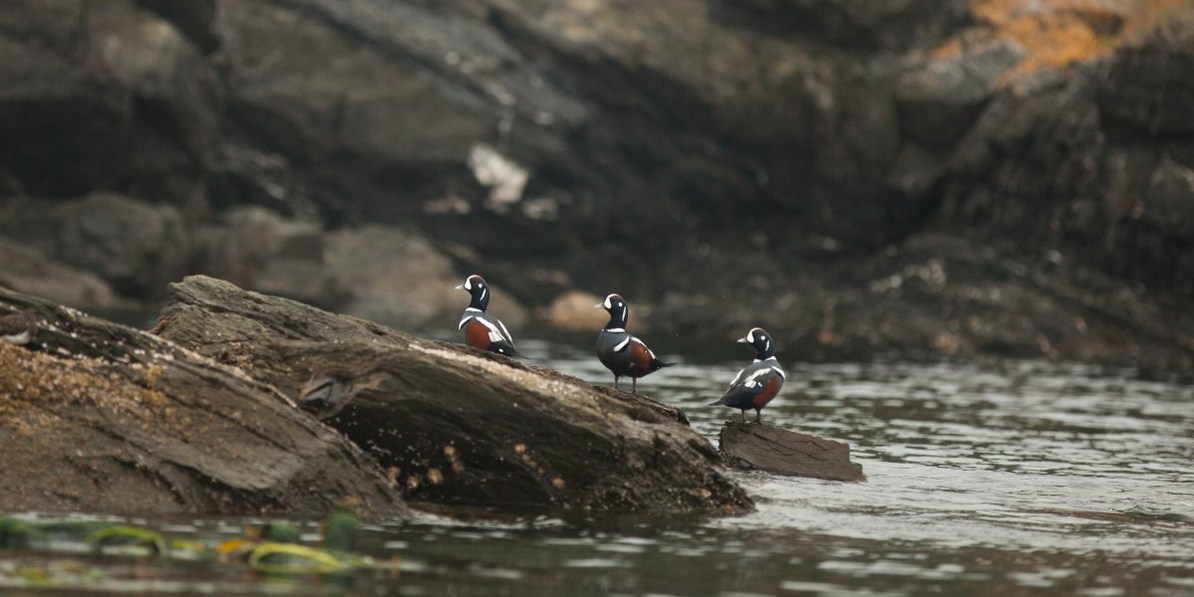
Harlequin ducks along the southern end of Lopez Island. Photo by Matthew Williams.
- Lopez Island: Shark Reef Sanctuary
- Lopez Island: Lopez Islander Resort
- Lopez Island: Spencer Spit State Park
- Lopez Island: Odlin County Park
- Lopez Island: Otis Perkins Day Park
- Lopez Island: Lopez Hill
- Shark Reef Sanctuary
- Lopez Island: Iceberg Point Hike
- Fisherman Bay Sea Kayaking
- Flower Island + Frost Island Sea Kayaking
- Mud Bay Sea Kayaking
- Charles Island + Long Island Sea Kayaking
Camping + Lodging
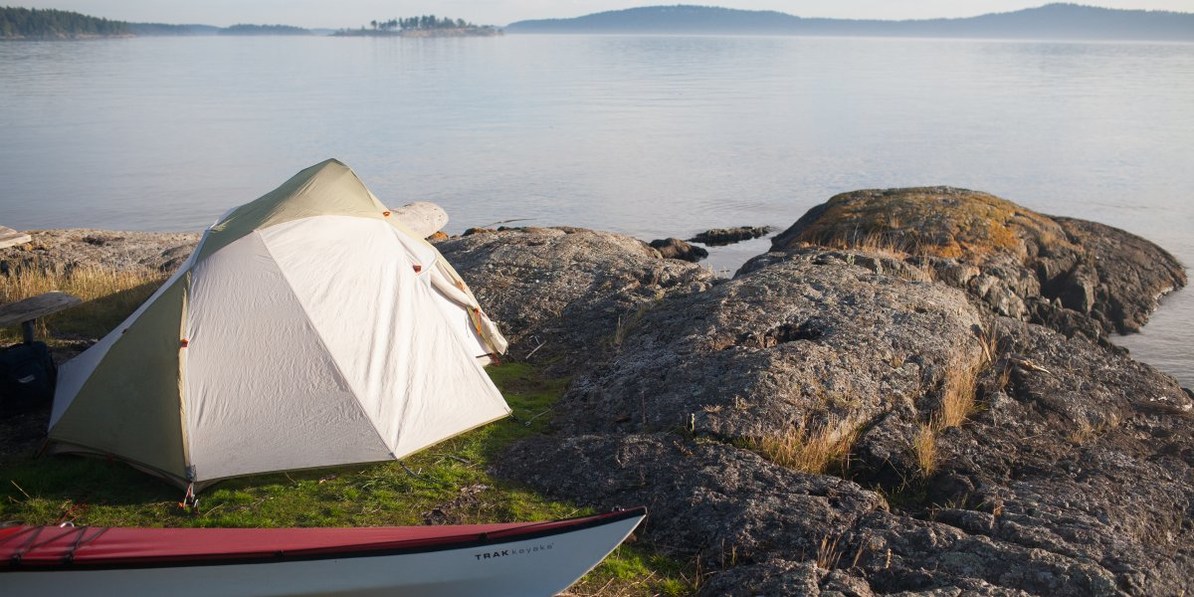
One of the beautiful campsites on Jones Island. Photo by Matthew Williams.
While camping can be a beautiful way to overnight throughout the islands, the reality is that there are very few campgrounds given the large number of tourists that visit the island throughout the year. If you are planning on camping in any of the more developed campgrounds, be sure to make reservations well in advance whenever possible. Smaller campgrounds and campsites related to the marine parks are generally first-come, first-served, so flexibility is essential when you are planning to use these resources.
Orcas Island
- Orcas Island: Moran State Park Campgrounds
- Eastsound Suites
- Beach Haven Resort
- The Landmark on Orcas Island
- Orcas Hotel
- Outlook Inn
- West Beach Resort
- Kingfish Inn
- Doe Bay Resort and Retreat
- Rosario Resort + Spa
- North Beach Inn
- Inn at Ship Bay
- Inn on Orcas Island
- Blue Heron Bed + Breakfast
- Turtleback Farm Inn
- Wally Fisher Lodge
San Juan Island
- San Juan Island: San Juan County Day Park + Campground
- Earthbox Inn + Spa
- Discovery Inn
- Tucker House Inn
- Bird Rock Hotel
- The Orca Inn
- The Friday Harbor Grand
- Island Inn at 123 West
- Juniper Lane Guest House
- Friday Harbor House
- Wayfarer's Rest Hostel
- Snug Harbor Resort
- Lonesome Cove Resort
- Roche Harbor Resort
- Lake Dale Resort and Campground at Three Lakes
Lopez Island
- Spencer Spit State Park Camping
- Odlin County Park Camping
- Lopez Farm Cottages + Tent Camping
- Lopez Islander Resort + Camping
- Mackaye Harbor Inn
- The Edenwild Boutique Inn
Other islands
Note that primitive sites are $12 per site year round, and garbage service is not provided at any of these islands; please take care to pack out what you pack in and Leave No Trace.
- Blind Island: Four primitive and first-come, first-served campsites available to human and wind-powered boat access. One toilet. No water.
- Clark Island: 15 primitive and first-come, first-served campsites, one reservable group site (call 360.376.2073), and three toilets. No water.
- Doe Island: Five primitive and first-come, first-served campsites and one vault toilet. No water.
- Hope Island: Four primitive and first-come, first-served campsites and one toilet. No water.
- James Island: 13 primitive and first-come, first-served campsites distributed in West Cove (three with a pit toilet), the Saddle area (six with a composting toilet), and East Cove (four with a pit toilet). No potable water. Access is restricted to camping areas and trails.
- Jones Island: 24 primitive and first-come, first-served campsites, six composting toilets, potable water from May through September. Visitors can access 4 miles of hiking trails.
- Matia Island: Six primitive and first-come, first-served campsites in Rolfe Cove. One composting toilet, no potable water. As an island wildlife refuge, the campground, beaches, and Loop Trail are the only portions of the island open to people, and no pets are allowed on the island.
- Patos Island: Seven primitive and first-come, first-served campsites and two toilets. No water. If you are here from Memorial Day through Labor Day, you may catch a lighthouse tour.
- Saddlebag Island: Five primitive and first-come, first-served campsites and one toilet. No water.
- Shaw Island: 11 primitive and first-come, first-served campsites, one group site, day use facilities, and vault toilets. Seasonal potable water (Memorial Day through Labor Day). Firewood is available.
- Skagit Island: A few primitive and first-come, first-served campsites and one toilet. No water.
- Stuart Island State Park has 18 primitive and first-come, first-served campsites near Prevost Harbor. There is potable water from April through September, and visitors will find composting toilets and portable toilets.
- Sucia Island: Highly regarded destination with 60 primitive and first-come, first-served campsites, four reservable group sites and several reservable day use facilities (call 360.376.2073), composting toilets, and potable water at Fossil Bay from April through September and at Echo and Shallow bays from May through September. Approximately 10 miles of trails.
- Turn Island: Eight primitive and first-come, first-served campsites, two composting toilets, and no potable water. As an island wildlife refuge, human access is limited to the camping areas and a short trail around the island. No pets are allowed on the island.
Ferries
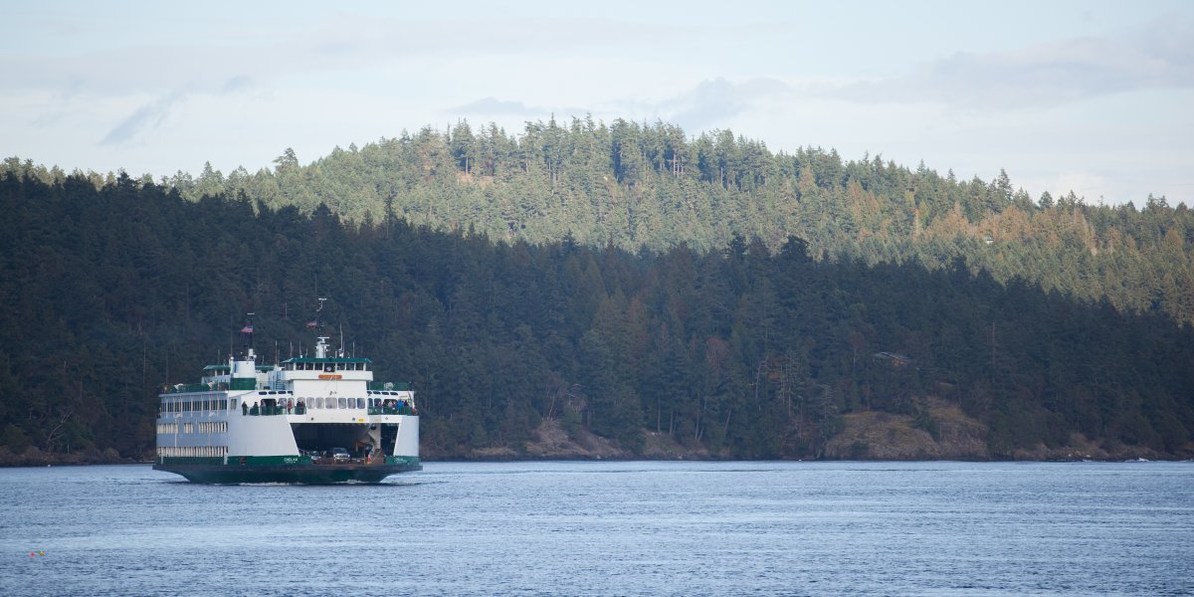
A ferry rounds the corner near Blind Island State Park. Photo by Matthew Williams.
Ferry service is a well established tradition in the San Juans, and each year these ferries shuttle thousands of visitors along with their cars, bikes, backpacks and sea kayaks through the islands. These large vessels have restrooms, some snack facilities, and plenty of seats and benches to enjoy the amazing views. Reservations are highly recommended, especially in peak season, though a portion of spaces are left for last-minute planners. Walk-on visitors don't need a reservation. The ferry service runs from Anacortes through Lopez, Shaw, Orcas, and San Juan islands before continuing to Sidney, B.C. The service is frequent enough to ensure that you'll have a few scheduling options in a day, and the price depends on your destination.
Weather + water hazards
While images of a tranquil sea surrounding small islands may dominate the imagination when it comes to the San Juan Islands, the reality can be much more tumultuous. These are Pacific Northwest waters that are subject to major storm systems that can settle in for days at a time. High winds and compromised visibility pose serious safety hazards to all types of boaters. Additionally, tides and currents throughout the archipelago can be notoriously tricky to safely negotiate, especially when ferry routes are added into the scenario. Certain channels, routes, and distances require advanced paddling skills, and waters here are frigid enough that capsizing can quickly become a life threatening situation. If you choose to sea kayak through the San Juans, please paddle within your skill set and training, and do not underestimate the hazards involved. In addition to essential survival and safety items, be sure to travel with a detailed map, compass, a tide chart, and a VHF radio to monitor shipping traffic.
Logistics + Planning
Current Weather: Powered by Dark Sky





















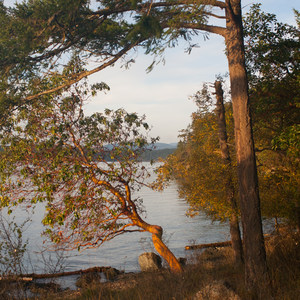

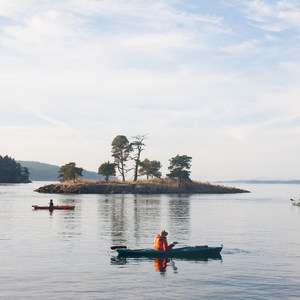
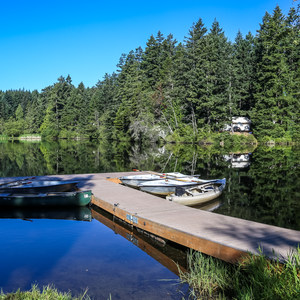
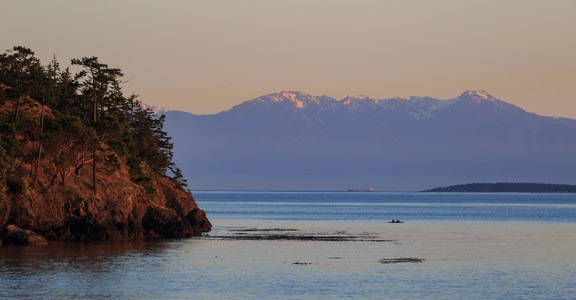
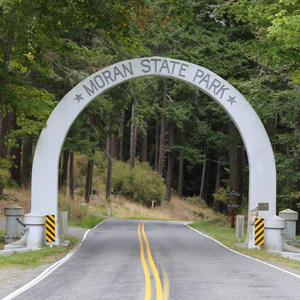



Comments
Sign In and share them.